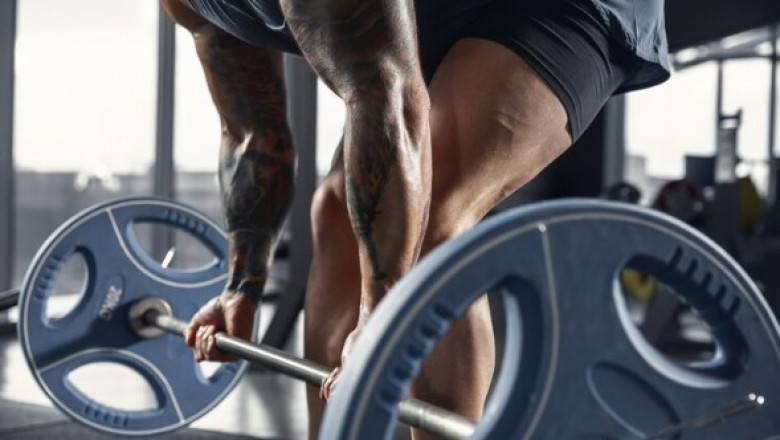views
Dealing with a slip disc can be a painful and frustrating experience, for those who enjoy weightlifting as part of their fitness routine. A slipped disc, also known as a herniated or bulging disc, occurs when one of the discs in the spine slips out of place, leading to intense pain and discomfort. For weightlifters, whether they can continue their gym routines with a slip disc becomes critical. Can you still lift weights without worsening the condition? This article highlights the impact of a slip disc on weightlifting, discusses the precautions you need to take, slip disc treatment and suggests safe exercises to help you continue your fitness journey while managing your back pain.
What Is a Slip Disc?
A slip disc, also referred to as a herniated or protruded disc, occurs when the inner gel-like substance of a spinal disc pushes through a tear in the outer disc wall. This can press on nearby nerves, causing pain, numbness, or weakness in the affected area.
The intervertebral discs act as cushions to absorb shock and allow movement. A slip disc happens when the disc’s outer layer weakens or tears, and the inner gel-like substance bulges out. This protrusion can press on spinal nerves, leading to pain or discomfort in the back, neck, arms, or legs.
Common signs include back pain, numbness or tingling in the limbs, weakness in muscles, and pain that radiates down the legs or arms. If you experience sharp, shooting pain, or find it difficult to move or perform daily tasks, seeking slip disc treatment is essential.
How a Slip Disc Affects Weightlifting
Weightlifting places stress on the spine, which is why individuals with a slip disc must be cautious when engaging in strength training. The lower back plays a crucial role in stabilising the body during lifts, and any pressure on a damaged disc can worsen the injury.
When lifting weights with poor form, the pressure exerted on the spine can be immense. A slip disc reduces the stability of the spinal column, making it more vulnerable to damage. Incorrect posture during lifts, such as rounding the back, can lead to increased pressure on the affected disc, causing it to protrude and aggravate the injury.
Can You Lift Weights with a Slip Disc?
The ability to continue lifting weights with a slip disc depends on factors like the severity of the herniation, the presence of nerve involvement, and how well your body responds to disc herniation treatment. If the slip disc is mild and you have no significant nerve damage, you may be able to continue with modified exercises.
Consult a doctor or physiotherapist who can evaluate your condition and provide a tailored treatment plan. They may suggest non-surgical back pain treatment methods such as spinal cord stimulation or specific exercises to help manage your condition and improve your mobility.
Exercises to Avoid with a Slip Disc
Heavy squats and deadlifts can put enormous pressure on the lower back. These exercises require proper form and posture, and any deviation from correct technique can worsen the condition of a slip disc.
Lifting heavy weights above your head may cause you to arch your back, aggravating the herniated disc. Modifications or avoiding this exercise is necessary.
Any high-impact movements or exercises that involve twisting the spine, such as some kettlebell exercises or Olympic lifts, should be avoided. These motions can strain the disc and increase the risk of further injury.
Safe Exercises for Strength Training with a Slip Disc
Core exercises, such as planks and bird dogs, can help stabilise the spine without placing excessive pressure on the disc. Strengthening the core muscles provides better support for the spine and can reduce the risk of injury.
Leg press machines, glute bridges, and hamstring curls are great exercises that focus on the lower body while reducing spinal load. Avoid exercises like squats and deadlifts, but these alternatives can help you maintain strength without aggravating your back.
When to Seek Medical Help
Warning signs that your condition is worsening include persistent pain, numbness, weakness, or loss of bowel or bladder control. If you experience any of these symptoms, it is crucial to seek immediate medical attention for pain treatment in Sydney.
A physical therapist can help you develop an exercise routine that promotes recovery, strengthens the muscles around the spine, and minimises the risk of injury. Regular visits to a healthcare professional are essential for monitoring your progress and making necessary adjustments to your disc protrusion treatment plan.
Conclusion
Dealing with a slip disc requires careful planning and consultation with healthcare professionals to ensure you’re not exacerbating the condition. By avoiding risky exercises, modifying your workout, and focusing on proper lifting techniques, you can still enjoy the benefits of strength training while protecting your spine. The key to managing a slip disc is patience, consistency, and taking the necessary steps to ensure safe recovery. If you’re unsure, seek professional advice or explore pain treatment options for spinal cord stimulation or disc protrusion to help you get back to the gym safely.






















Comments
0 comment